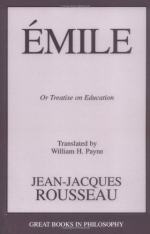Everything which cramps and confines nature is in bad taste; this is as true of the adornments of the person as of the ornaments of the mind. Life, health, common-sense, and comfort must come first; there is no grace in discomfort, languor is not refinement, there is no charm in ill-health; suffering may excite pity, but pleasure and delight demand the freshness of health.
Boys and girls have many games in common, and this is as it should be; do they not play together when they are grown up? They have also special tastes of their own. Boys want movement and noise, drums, tops, toy-carts; girls prefer things which appeal to the eye, and can be used for dressing-up—mirrors, jewellery, finery, and specially dolls. The doll is the girl’s special plaything; this shows her instinctive bent towards her life’s work. The art of pleasing finds its physical basis in personal adornment, and this physical side of the art is the only one which the child can cultivate.
Here is a little girl busy all day with her doll; she is always changing its clothes, dressing and undressing it, trying new combinations of trimmings well or ill matched; her fingers are clumsy, her taste is crude, but there is no mistaking her bent; in this endless occupation time flies unheeded, the hours slip away unnoticed, even meals are forgotten. She is more eager for adornment than for food. “But she is dressing her doll, not herself,” you will say. Just so; she sees her doll, she cannot see herself; she cannot do anything for herself, she has neither the training, nor the talent, nor the strength; as yet she herself is nothing, she is engrossed in her doll and all her coquetry is devoted to it. This will not always be so; in due time she will be her own doll.
We have here a very early and clearly-marked bent; you have only to follow it and train it. What the little girl most clearly desires is to dress her doll, to make its bows, its tippets, its sashes, and its tuckers; she is dependent on other people’s kindness in all this, and it would be much pleasanter to be able to do it herself. Here is a motive for her earliest lessons, they are not tasks prescribed, but favours bestowed. Little girls always dislike learning to read and write, but they are always ready to learn to sew. They think they are grown up, and in imagination they are using their knowledge for their own adornment.
The way is open and it is easy to follow it; cutting out, embroidery, lace-making follow naturally. Tapestry is not popular; furniture is too remote from the child’s interests, it has nothing to do with the person, it depends on conventional tastes. Tapestry is a woman’s amusement; young girls never care for it.




